Analyzing Mental Tourism: Demand, Supply, and Challenges in India
VerifiedAdded on 2022/10/08
|14
|3644
|16
Essay
AI Summary
This essay provides a comprehensive analysis of mental tourism in India, examining its growth, the factors driving it, and the challenges faced by the healthcare system. It begins by defining medical tourism and its evolution, specifically focusing on India's increasing popularity as a destination. The essay explores the demand and supply dynamics of healthcare in India, highlighting the financial burden on low-income earners and the impact of private health insurance. It delves into the dual healthcare system, the low penetration of health insurance, and the structural determinants influencing healthcare utilization. The analysis further examines government expenditure versus private out-of-pocket consumption, revealing significant challenges. Finally, the essay discusses specific challenges related to mental tourism, including the workload on nurses, the impact of the oil slump, and other factors affecting the quality and accessibility of mental healthcare. The essay uses various sources to support its arguments, including the Indian government's initiatives to promote medical tourism, the role of private firms, and the training of Indian doctors. The essay also discusses the limitations of the public healthcare system, the shortage of resources, and the impact of these factors on the quality of mental healthcare.
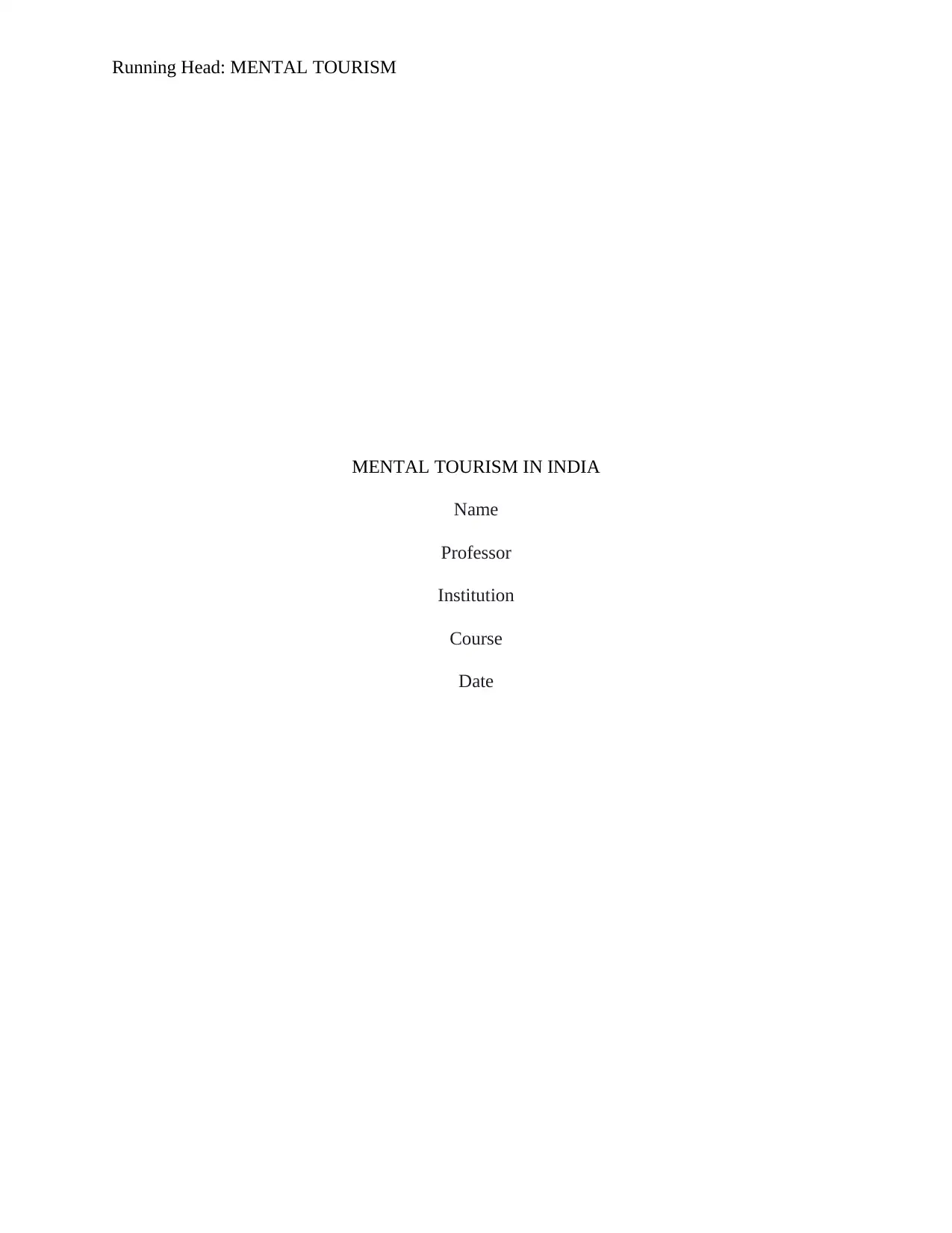
Running Head: MENTAL TOURISM
MENTAL TOURISM IN INDIA
Name
Professor
Institution
Course
Date
MENTAL TOURISM IN INDIA
Name
Professor
Institution
Course
Date
Paraphrase This Document
Need a fresh take? Get an instant paraphrase of this document with our AI Paraphraser
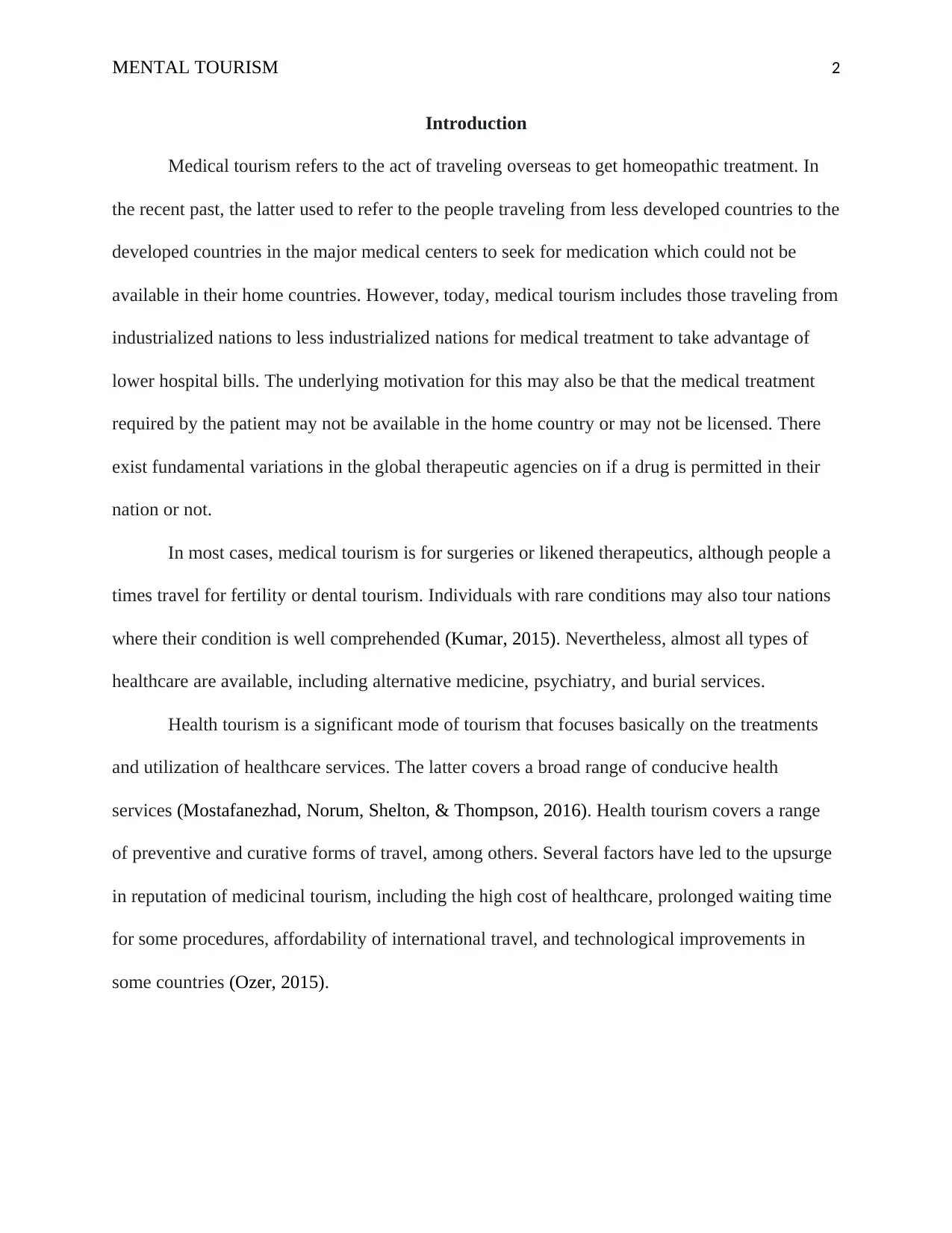
MENTAL TOURISM 2
Introduction
Medical tourism refers to the act of traveling overseas to get homeopathic treatment. In
the recent past, the latter used to refer to the people traveling from less developed countries to the
developed countries in the major medical centers to seek for medication which could not be
available in their home countries. However, today, medical tourism includes those traveling from
industrialized nations to less industrialized nations for medical treatment to take advantage of
lower hospital bills. The underlying motivation for this may also be that the medical treatment
required by the patient may not be available in the home country or may not be licensed. There
exist fundamental variations in the global therapeutic agencies on if a drug is permitted in their
nation or not.
In most cases, medical tourism is for surgeries or likened therapeutics, although people a
times travel for fertility or dental tourism. Individuals with rare conditions may also tour nations
where their condition is well comprehended (Kumar, 2015). Nevertheless, almost all types of
healthcare are available, including alternative medicine, psychiatry, and burial services.
Health tourism is a significant mode of tourism that focuses basically on the treatments
and utilization of healthcare services. The latter covers a broad range of conducive health
services (Mostafanezhad, Norum, Shelton, & Thompson, 2016). Health tourism covers a range
of preventive and curative forms of travel, among others. Several factors have led to the upsurge
in reputation of medicinal tourism, including the high cost of healthcare, prolonged waiting time
for some procedures, affordability of international travel, and technological improvements in
some countries (Ozer, 2015).
Introduction
Medical tourism refers to the act of traveling overseas to get homeopathic treatment. In
the recent past, the latter used to refer to the people traveling from less developed countries to the
developed countries in the major medical centers to seek for medication which could not be
available in their home countries. However, today, medical tourism includes those traveling from
industrialized nations to less industrialized nations for medical treatment to take advantage of
lower hospital bills. The underlying motivation for this may also be that the medical treatment
required by the patient may not be available in the home country or may not be licensed. There
exist fundamental variations in the global therapeutic agencies on if a drug is permitted in their
nation or not.
In most cases, medical tourism is for surgeries or likened therapeutics, although people a
times travel for fertility or dental tourism. Individuals with rare conditions may also tour nations
where their condition is well comprehended (Kumar, 2015). Nevertheless, almost all types of
healthcare are available, including alternative medicine, psychiatry, and burial services.
Health tourism is a significant mode of tourism that focuses basically on the treatments
and utilization of healthcare services. The latter covers a broad range of conducive health
services (Mostafanezhad, Norum, Shelton, & Thompson, 2016). Health tourism covers a range
of preventive and curative forms of travel, among others. Several factors have led to the upsurge
in reputation of medicinal tourism, including the high cost of healthcare, prolonged waiting time
for some procedures, affordability of international travel, and technological improvements in
some countries (Ozer, 2015).
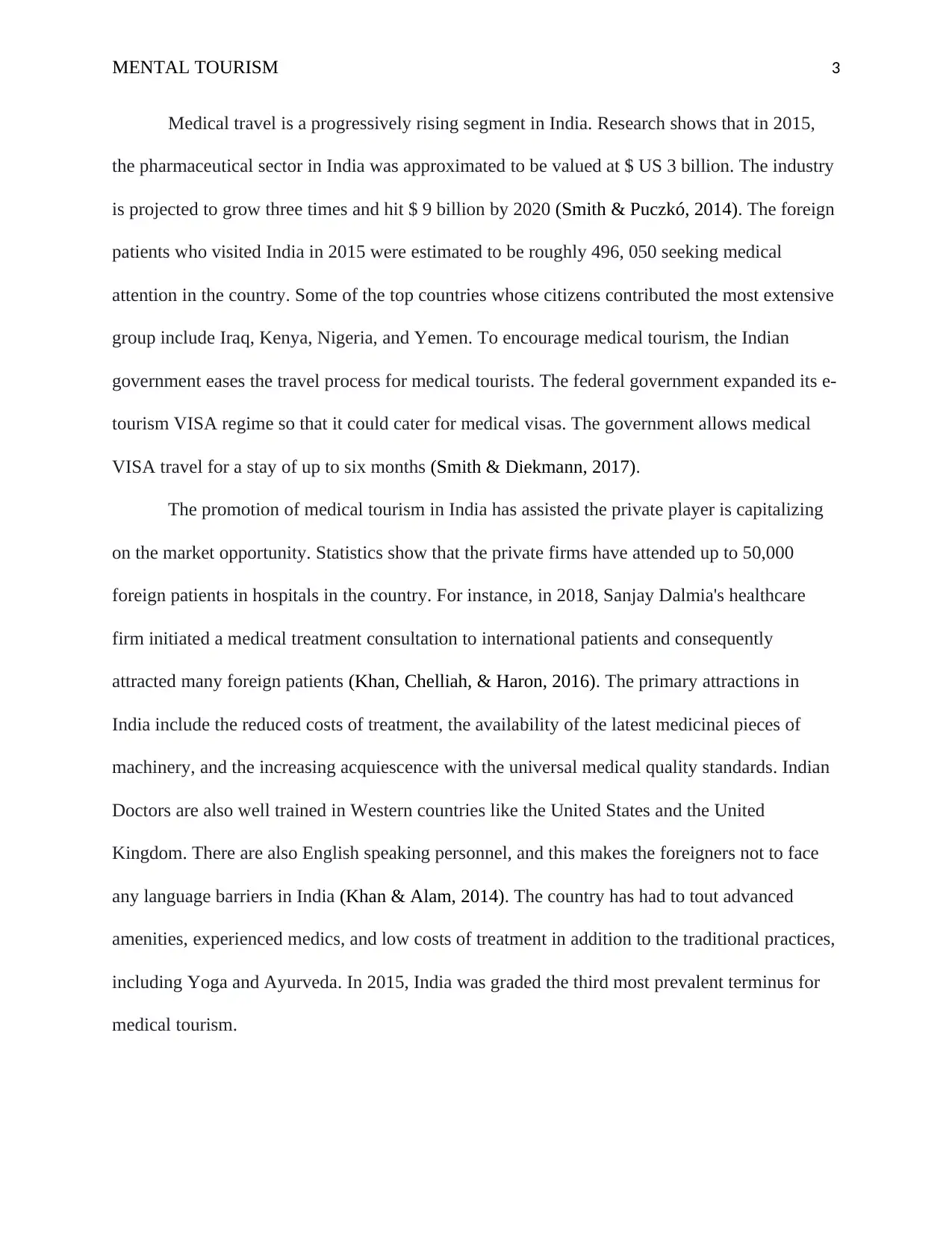
MENTAL TOURISM 3
Medical travel is a progressively rising segment in India. Research shows that in 2015,
the pharmaceutical sector in India was approximated to be valued at $ US 3 billion. The industry
is projected to grow three times and hit $ 9 billion by 2020 (Smith & Puczkó, 2014). The foreign
patients who visited India in 2015 were estimated to be roughly 496, 050 seeking medical
attention in the country. Some of the top countries whose citizens contributed the most extensive
group include Iraq, Kenya, Nigeria, and Yemen. To encourage medical tourism, the Indian
government eases the travel process for medical tourists. The federal government expanded its e-
tourism VISA regime so that it could cater for medical visas. The government allows medical
VISA travel for a stay of up to six months (Smith & Diekmann, 2017).
The promotion of medical tourism in India has assisted the private player is capitalizing
on the market opportunity. Statistics show that the private firms have attended up to 50,000
foreign patients in hospitals in the country. For instance, in 2018, Sanjay Dalmia's healthcare
firm initiated a medical treatment consultation to international patients and consequently
attracted many foreign patients (Khan, Chelliah, & Haron, 2016). The primary attractions in
India include the reduced costs of treatment, the availability of the latest medicinal pieces of
machinery, and the increasing acquiescence with the universal medical quality standards. Indian
Doctors are also well trained in Western countries like the United States and the United
Kingdom. There are also English speaking personnel, and this makes the foreigners not to face
any language barriers in India (Khan & Alam, 2014). The country has had to tout advanced
amenities, experienced medics, and low costs of treatment in addition to the traditional practices,
including Yoga and Ayurveda. In 2015, India was graded the third most prevalent terminus for
medical tourism.
Medical travel is a progressively rising segment in India. Research shows that in 2015,
the pharmaceutical sector in India was approximated to be valued at $ US 3 billion. The industry
is projected to grow three times and hit $ 9 billion by 2020 (Smith & Puczkó, 2014). The foreign
patients who visited India in 2015 were estimated to be roughly 496, 050 seeking medical
attention in the country. Some of the top countries whose citizens contributed the most extensive
group include Iraq, Kenya, Nigeria, and Yemen. To encourage medical tourism, the Indian
government eases the travel process for medical tourists. The federal government expanded its e-
tourism VISA regime so that it could cater for medical visas. The government allows medical
VISA travel for a stay of up to six months (Smith & Diekmann, 2017).
The promotion of medical tourism in India has assisted the private player is capitalizing
on the market opportunity. Statistics show that the private firms have attended up to 50,000
foreign patients in hospitals in the country. For instance, in 2018, Sanjay Dalmia's healthcare
firm initiated a medical treatment consultation to international patients and consequently
attracted many foreign patients (Khan, Chelliah, & Haron, 2016). The primary attractions in
India include the reduced costs of treatment, the availability of the latest medicinal pieces of
machinery, and the increasing acquiescence with the universal medical quality standards. Indian
Doctors are also well trained in Western countries like the United States and the United
Kingdom. There are also English speaking personnel, and this makes the foreigners not to face
any language barriers in India (Khan & Alam, 2014). The country has had to tout advanced
amenities, experienced medics, and low costs of treatment in addition to the traditional practices,
including Yoga and Ayurveda. In 2015, India was graded the third most prevalent terminus for
medical tourism.
⊘ This is a preview!⊘
Do you want full access?
Subscribe today to unlock all pages.

Trusted by 1+ million students worldwide
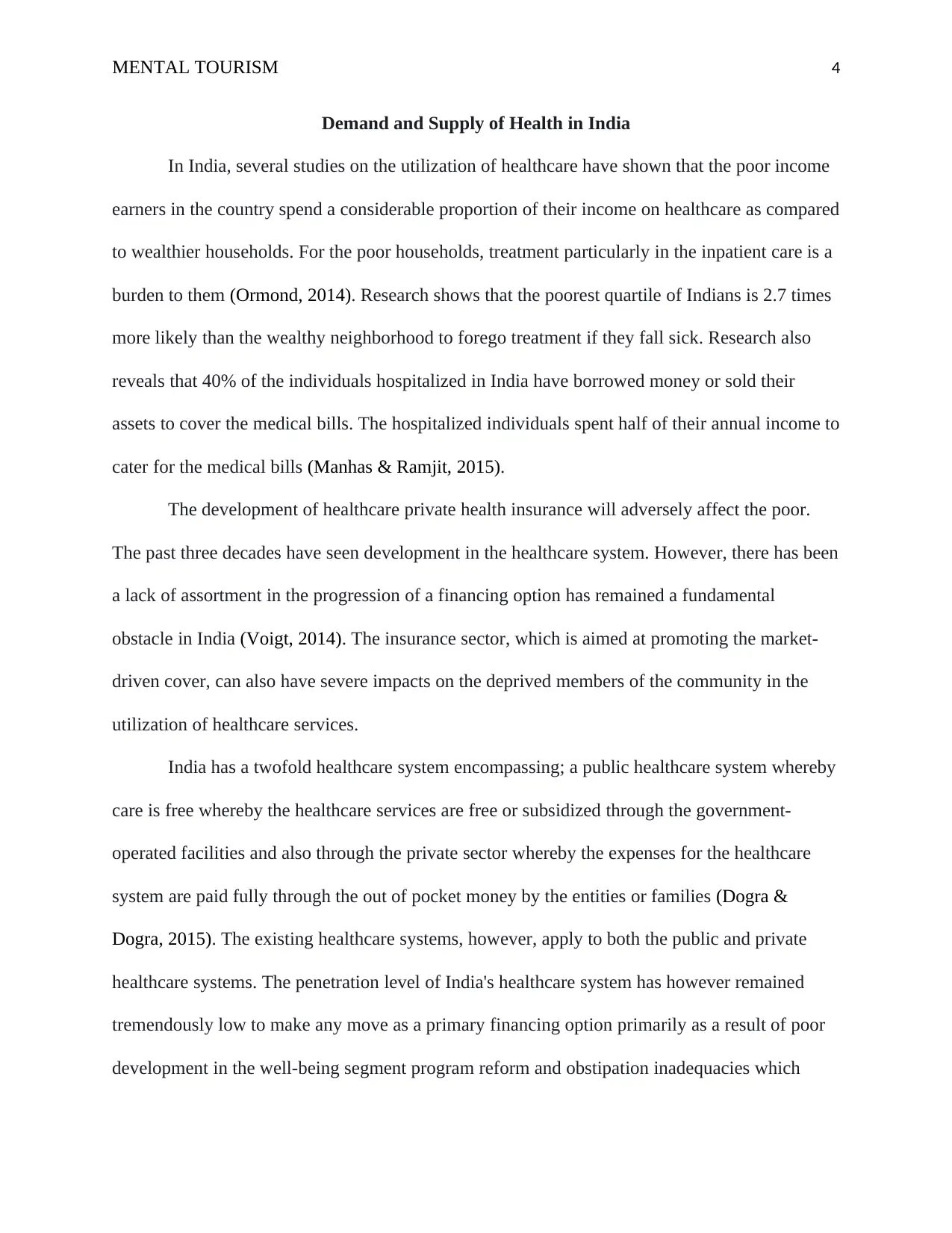
MENTAL TOURISM 4
Demand and Supply of Health in India
In India, several studies on the utilization of healthcare have shown that the poor income
earners in the country spend a considerable proportion of their income on healthcare as compared
to wealthier households. For the poor households, treatment particularly in the inpatient care is a
burden to them (Ormond, 2014). Research shows that the poorest quartile of Indians is 2.7 times
more likely than the wealthy neighborhood to forego treatment if they fall sick. Research also
reveals that 40% of the individuals hospitalized in India have borrowed money or sold their
assets to cover the medical bills. The hospitalized individuals spent half of their annual income to
cater for the medical bills (Manhas & Ramjit, 2015).
The development of healthcare private health insurance will adversely affect the poor.
The past three decades have seen development in the healthcare system. However, there has been
a lack of assortment in the progression of a financing option has remained a fundamental
obstacle in India (Voigt, 2014). The insurance sector, which is aimed at promoting the market-
driven cover, can also have severe impacts on the deprived members of the community in the
utilization of healthcare services.
India has a twofold healthcare system encompassing; a public healthcare system whereby
care is free whereby the healthcare services are free or subsidized through the government-
operated facilities and also through the private sector whereby the expenses for the healthcare
system are paid fully through the out of pocket money by the entities or families (Dogra &
Dogra, 2015). The existing healthcare systems, however, apply to both the public and private
healthcare systems. The penetration level of India's healthcare system has however remained
tremendously low to make any move as a primary financing option primarily as a result of poor
development in the well-being segment program reform and obstipation inadequacies which
Demand and Supply of Health in India
In India, several studies on the utilization of healthcare have shown that the poor income
earners in the country spend a considerable proportion of their income on healthcare as compared
to wealthier households. For the poor households, treatment particularly in the inpatient care is a
burden to them (Ormond, 2014). Research shows that the poorest quartile of Indians is 2.7 times
more likely than the wealthy neighborhood to forego treatment if they fall sick. Research also
reveals that 40% of the individuals hospitalized in India have borrowed money or sold their
assets to cover the medical bills. The hospitalized individuals spent half of their annual income to
cater for the medical bills (Manhas & Ramjit, 2015).
The development of healthcare private health insurance will adversely affect the poor.
The past three decades have seen development in the healthcare system. However, there has been
a lack of assortment in the progression of a financing option has remained a fundamental
obstacle in India (Voigt, 2014). The insurance sector, which is aimed at promoting the market-
driven cover, can also have severe impacts on the deprived members of the community in the
utilization of healthcare services.
India has a twofold healthcare system encompassing; a public healthcare system whereby
care is free whereby the healthcare services are free or subsidized through the government-
operated facilities and also through the private sector whereby the expenses for the healthcare
system are paid fully through the out of pocket money by the entities or families (Dogra &
Dogra, 2015). The existing healthcare systems, however, apply to both the public and private
healthcare systems. The penetration level of India's healthcare system has however remained
tremendously low to make any move as a primary financing option primarily as a result of poor
development in the well-being segment program reform and obstipation inadequacies which
Paraphrase This Document
Need a fresh take? Get an instant paraphrase of this document with our AI Paraphraser
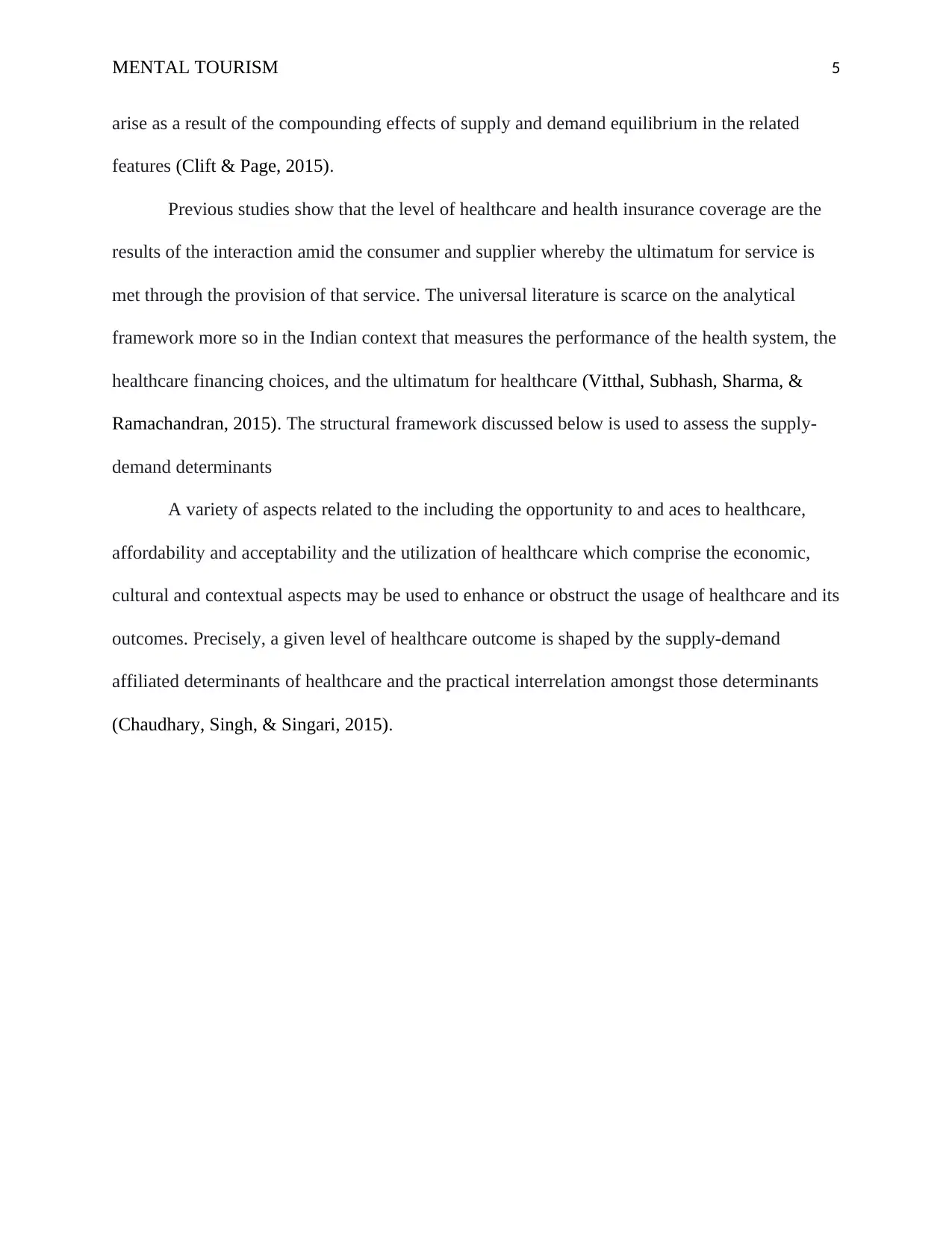
MENTAL TOURISM 5
arise as a result of the compounding effects of supply and demand equilibrium in the related
features (Clift & Page, 2015).
Previous studies show that the level of healthcare and health insurance coverage are the
results of the interaction amid the consumer and supplier whereby the ultimatum for service is
met through the provision of that service. The universal literature is scarce on the analytical
framework more so in the Indian context that measures the performance of the health system, the
healthcare financing choices, and the ultimatum for healthcare (Vitthal, Subhash, Sharma, &
Ramachandran, 2015). The structural framework discussed below is used to assess the supply-
demand determinants
A variety of aspects related to the including the opportunity to and aces to healthcare,
affordability and acceptability and the utilization of healthcare which comprise the economic,
cultural and contextual aspects may be used to enhance or obstruct the usage of healthcare and its
outcomes. Precisely, a given level of healthcare outcome is shaped by the supply-demand
affiliated determinants of healthcare and the practical interrelation amongst those determinants
(Chaudhary, Singh, & Singari, 2015).
arise as a result of the compounding effects of supply and demand equilibrium in the related
features (Clift & Page, 2015).
Previous studies show that the level of healthcare and health insurance coverage are the
results of the interaction amid the consumer and supplier whereby the ultimatum for service is
met through the provision of that service. The universal literature is scarce on the analytical
framework more so in the Indian context that measures the performance of the health system, the
healthcare financing choices, and the ultimatum for healthcare (Vitthal, Subhash, Sharma, &
Ramachandran, 2015). The structural framework discussed below is used to assess the supply-
demand determinants
A variety of aspects related to the including the opportunity to and aces to healthcare,
affordability and acceptability and the utilization of healthcare which comprise the economic,
cultural and contextual aspects may be used to enhance or obstruct the usage of healthcare and its
outcomes. Precisely, a given level of healthcare outcome is shaped by the supply-demand
affiliated determinants of healthcare and the practical interrelation amongst those determinants
(Chaudhary, Singh, & Singari, 2015).
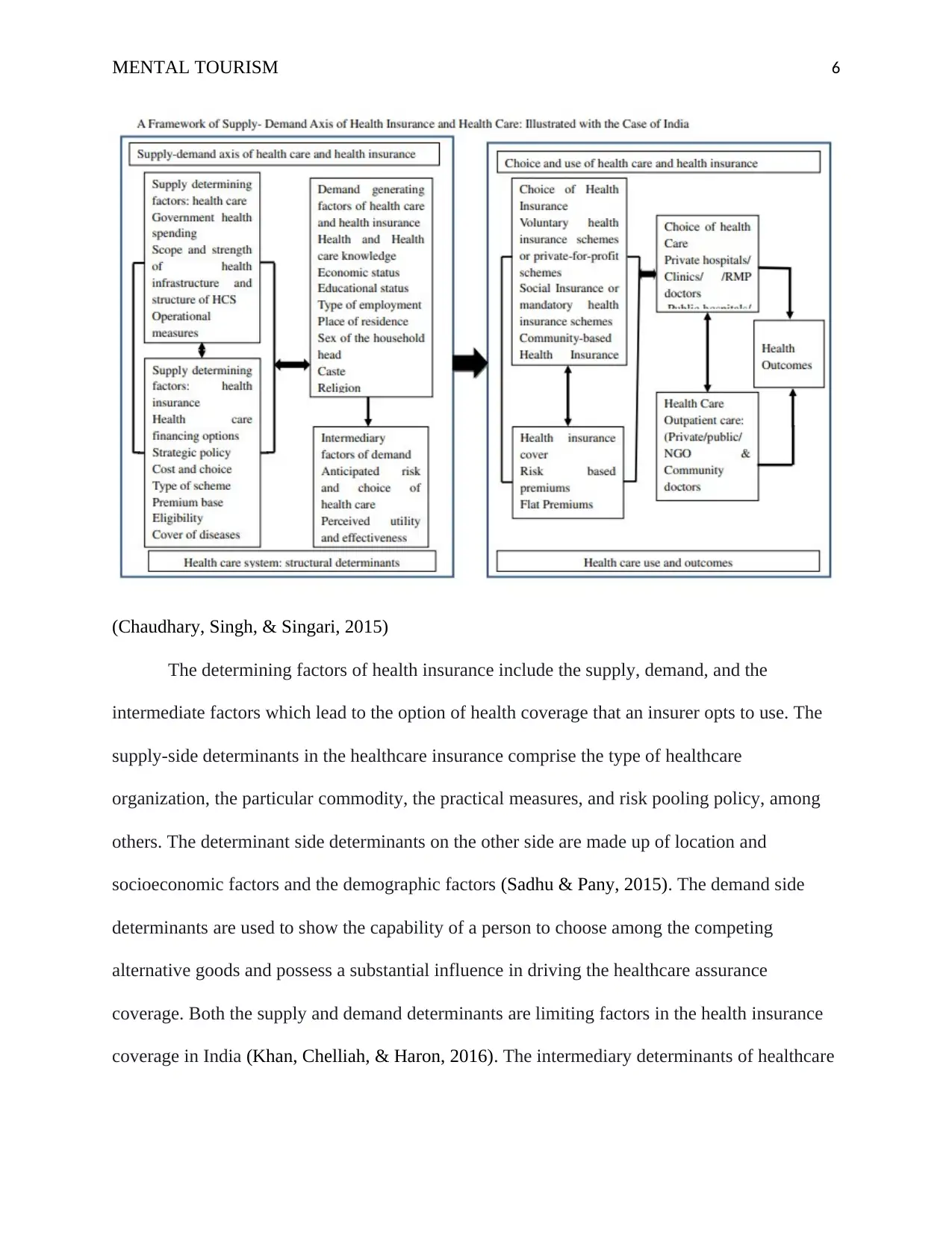
MENTAL TOURISM 6
(Chaudhary, Singh, & Singari, 2015)
The determining factors of health insurance include the supply, demand, and the
intermediate factors which lead to the option of health coverage that an insurer opts to use. The
supply-side determinants in the healthcare insurance comprise the type of healthcare
organization, the particular commodity, the practical measures, and risk pooling policy, among
others. The determinant side determinants on the other side are made up of location and
socioeconomic factors and the demographic factors (Sadhu & Pany, 2015). The demand side
determinants are used to show the capability of a person to choose among the competing
alternative goods and possess a substantial influence in driving the healthcare assurance
coverage. Both the supply and demand determinants are limiting factors in the health insurance
coverage in India (Khan, Chelliah, & Haron, 2016). The intermediary determinants of healthcare
(Chaudhary, Singh, & Singari, 2015)
The determining factors of health insurance include the supply, demand, and the
intermediate factors which lead to the option of health coverage that an insurer opts to use. The
supply-side determinants in the healthcare insurance comprise the type of healthcare
organization, the particular commodity, the practical measures, and risk pooling policy, among
others. The determinant side determinants on the other side are made up of location and
socioeconomic factors and the demographic factors (Sadhu & Pany, 2015). The demand side
determinants are used to show the capability of a person to choose among the competing
alternative goods and possess a substantial influence in driving the healthcare assurance
coverage. Both the supply and demand determinants are limiting factors in the health insurance
coverage in India (Khan, Chelliah, & Haron, 2016). The intermediary determinants of healthcare
⊘ This is a preview!⊘
Do you want full access?
Subscribe today to unlock all pages.

Trusted by 1+ million students worldwide
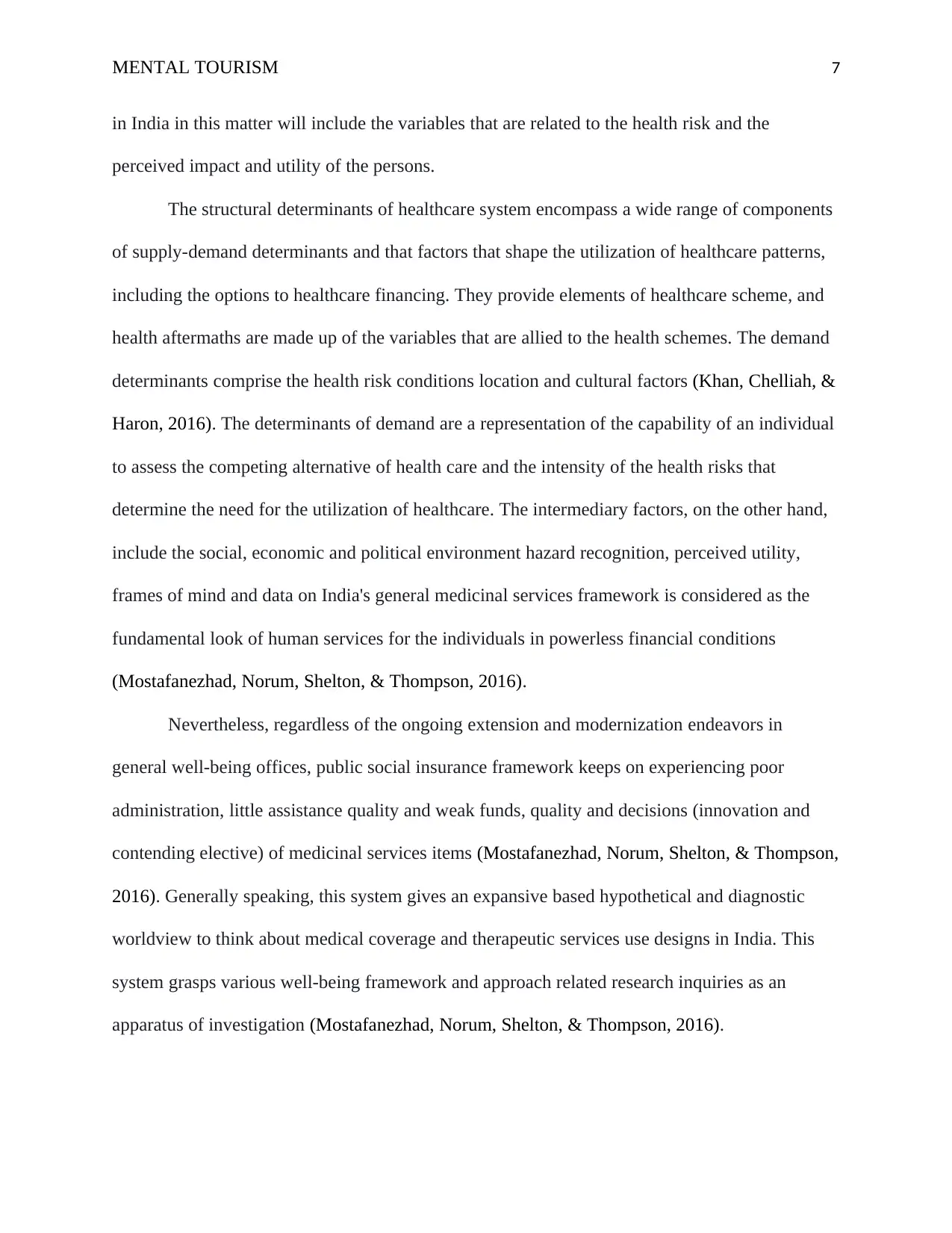
MENTAL TOURISM 7
in India in this matter will include the variables that are related to the health risk and the
perceived impact and utility of the persons.
The structural determinants of healthcare system encompass a wide range of components
of supply-demand determinants and that factors that shape the utilization of healthcare patterns,
including the options to healthcare financing. They provide elements of healthcare scheme, and
health aftermaths are made up of the variables that are allied to the health schemes. The demand
determinants comprise the health risk conditions location and cultural factors (Khan, Chelliah, &
Haron, 2016). The determinants of demand are a representation of the capability of an individual
to assess the competing alternative of health care and the intensity of the health risks that
determine the need for the utilization of healthcare. The intermediary factors, on the other hand,
include the social, economic and political environment hazard recognition, perceived utility,
frames of mind and data on India's general medicinal services framework is considered as the
fundamental look of human services for the individuals in powerless financial conditions
(Mostafanezhad, Norum, Shelton, & Thompson, 2016).
Nevertheless, regardless of the ongoing extension and modernization endeavors in
general well-being offices, public social insurance framework keeps on experiencing poor
administration, little assistance quality and weak funds, quality and decisions (innovation and
contending elective) of medicinal services items (Mostafanezhad, Norum, Shelton, & Thompson,
2016). Generally speaking, this system gives an expansive based hypothetical and diagnostic
worldview to think about medical coverage and therapeutic services use designs in India. This
system grasps various well-being framework and approach related research inquiries as an
apparatus of investigation (Mostafanezhad, Norum, Shelton, & Thompson, 2016).
in India in this matter will include the variables that are related to the health risk and the
perceived impact and utility of the persons.
The structural determinants of healthcare system encompass a wide range of components
of supply-demand determinants and that factors that shape the utilization of healthcare patterns,
including the options to healthcare financing. They provide elements of healthcare scheme, and
health aftermaths are made up of the variables that are allied to the health schemes. The demand
determinants comprise the health risk conditions location and cultural factors (Khan, Chelliah, &
Haron, 2016). The determinants of demand are a representation of the capability of an individual
to assess the competing alternative of health care and the intensity of the health risks that
determine the need for the utilization of healthcare. The intermediary factors, on the other hand,
include the social, economic and political environment hazard recognition, perceived utility,
frames of mind and data on India's general medicinal services framework is considered as the
fundamental look of human services for the individuals in powerless financial conditions
(Mostafanezhad, Norum, Shelton, & Thompson, 2016).
Nevertheless, regardless of the ongoing extension and modernization endeavors in
general well-being offices, public social insurance framework keeps on experiencing poor
administration, little assistance quality and weak funds, quality and decisions (innovation and
contending elective) of medicinal services items (Mostafanezhad, Norum, Shelton, & Thompson,
2016). Generally speaking, this system gives an expansive based hypothetical and diagnostic
worldview to think about medical coverage and therapeutic services use designs in India. This
system grasps various well-being framework and approach related research inquiries as an
apparatus of investigation (Mostafanezhad, Norum, Shelton, & Thompson, 2016).
Paraphrase This Document
Need a fresh take? Get an instant paraphrase of this document with our AI Paraphraser
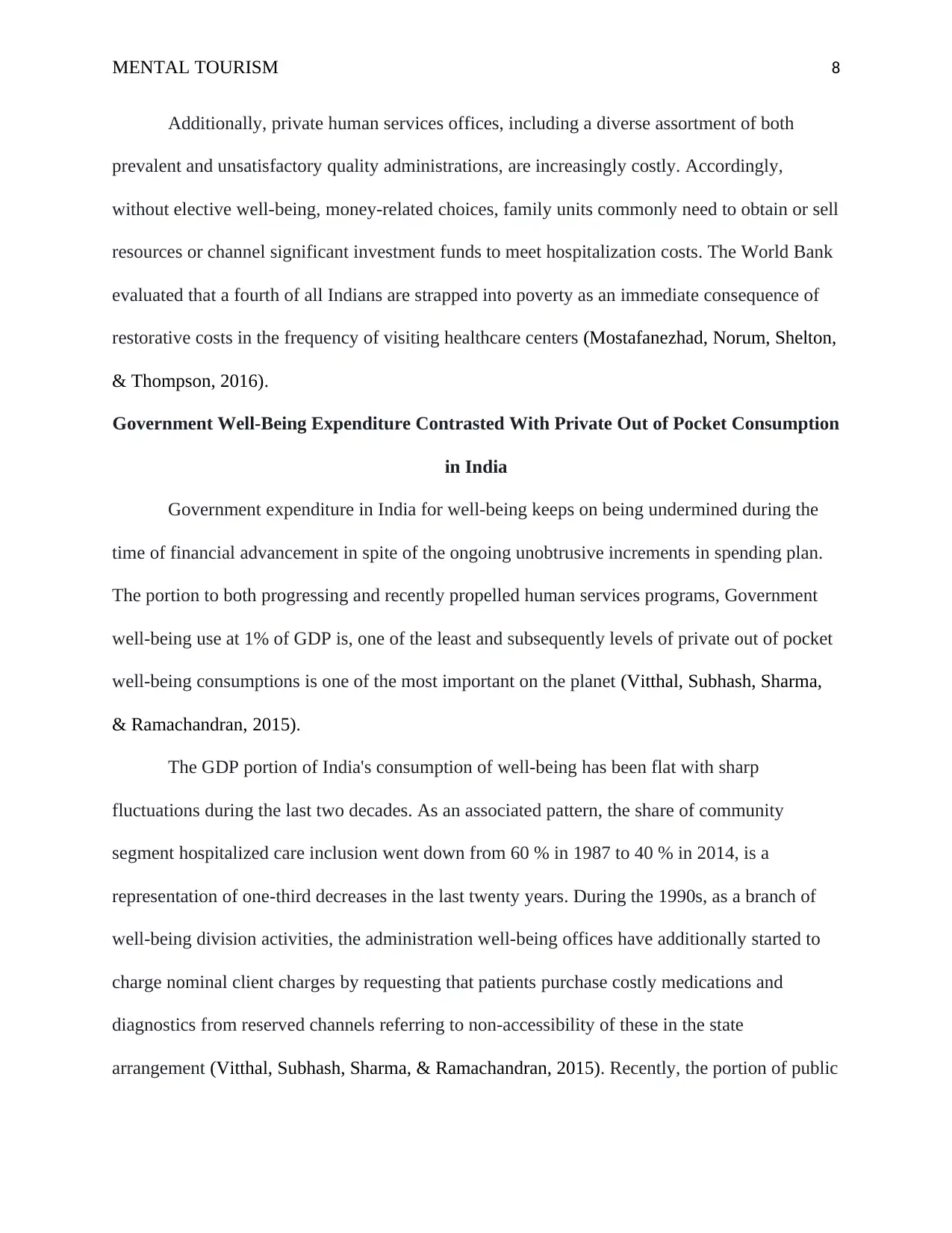
MENTAL TOURISM 8
Additionally, private human services offices, including a diverse assortment of both
prevalent and unsatisfactory quality administrations, are increasingly costly. Accordingly,
without elective well-being, money-related choices, family units commonly need to obtain or sell
resources or channel significant investment funds to meet hospitalization costs. The World Bank
evaluated that a fourth of all Indians are strapped into poverty as an immediate consequence of
restorative costs in the frequency of visiting healthcare centers (Mostafanezhad, Norum, Shelton,
& Thompson, 2016).
Government Well-Being Expenditure Contrasted With Private Out of Pocket Consumption
in India
Government expenditure in India for well-being keeps on being undermined during the
time of financial advancement in spite of the ongoing unobtrusive increments in spending plan.
The portion to both progressing and recently propelled human services programs, Government
well-being use at 1% of GDP is, one of the least and subsequently levels of private out of pocket
well-being consumptions is one of the most important on the planet (Vitthal, Subhash, Sharma,
& Ramachandran, 2015).
The GDP portion of India's consumption of well-being has been flat with sharp
fluctuations during the last two decades. As an associated pattern, the share of community
segment hospitalized care inclusion went down from 60 % in 1987 to 40 % in 2014, is a
representation of one-third decreases in the last twenty years. During the 1990s, as a branch of
well-being division activities, the administration well-being offices have additionally started to
charge nominal client charges by requesting that patients purchase costly medications and
diagnostics from reserved channels referring to non-accessibility of these in the state
arrangement (Vitthal, Subhash, Sharma, & Ramachandran, 2015). Recently, the portion of public
Additionally, private human services offices, including a diverse assortment of both
prevalent and unsatisfactory quality administrations, are increasingly costly. Accordingly,
without elective well-being, money-related choices, family units commonly need to obtain or sell
resources or channel significant investment funds to meet hospitalization costs. The World Bank
evaluated that a fourth of all Indians are strapped into poverty as an immediate consequence of
restorative costs in the frequency of visiting healthcare centers (Mostafanezhad, Norum, Shelton,
& Thompson, 2016).
Government Well-Being Expenditure Contrasted With Private Out of Pocket Consumption
in India
Government expenditure in India for well-being keeps on being undermined during the
time of financial advancement in spite of the ongoing unobtrusive increments in spending plan.
The portion to both progressing and recently propelled human services programs, Government
well-being use at 1% of GDP is, one of the least and subsequently levels of private out of pocket
well-being consumptions is one of the most important on the planet (Vitthal, Subhash, Sharma,
& Ramachandran, 2015).
The GDP portion of India's consumption of well-being has been flat with sharp
fluctuations during the last two decades. As an associated pattern, the share of community
segment hospitalized care inclusion went down from 60 % in 1987 to 40 % in 2014, is a
representation of one-third decreases in the last twenty years. During the 1990s, as a branch of
well-being division activities, the administration well-being offices have additionally started to
charge nominal client charges by requesting that patients purchase costly medications and
diagnostics from reserved channels referring to non-accessibility of these in the state
arrangement (Vitthal, Subhash, Sharma, & Ramachandran, 2015). Recently, the portion of public
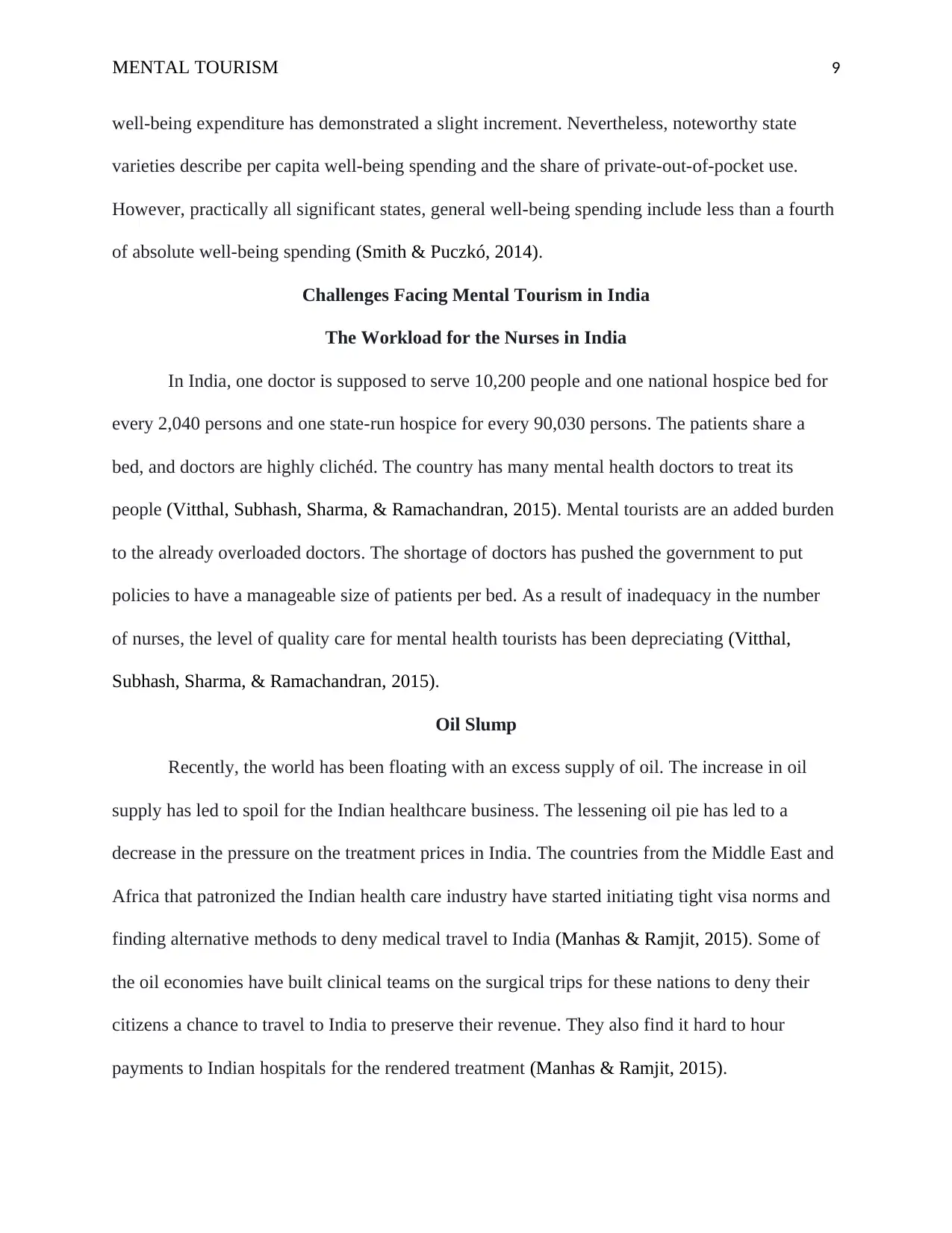
MENTAL TOURISM 9
well-being expenditure has demonstrated a slight increment. Nevertheless, noteworthy state
varieties describe per capita well-being spending and the share of private-out-of-pocket use.
However, practically all significant states, general well-being spending include less than a fourth
of absolute well-being spending (Smith & Puczkó, 2014).
Challenges Facing Mental Tourism in India
The Workload for the Nurses in India
In India, one doctor is supposed to serve 10,200 people and one national hospice bed for
every 2,040 persons and one state-run hospice for every 90,030 persons. The patients share a
bed, and doctors are highly clichéd. The country has many mental health doctors to treat its
people (Vitthal, Subhash, Sharma, & Ramachandran, 2015). Mental tourists are an added burden
to the already overloaded doctors. The shortage of doctors has pushed the government to put
policies to have a manageable size of patients per bed. As a result of inadequacy in the number
of nurses, the level of quality care for mental health tourists has been depreciating (Vitthal,
Subhash, Sharma, & Ramachandran, 2015).
Oil Slump
Recently, the world has been floating with an excess supply of oil. The increase in oil
supply has led to spoil for the Indian healthcare business. The lessening oil pie has led to a
decrease in the pressure on the treatment prices in India. The countries from the Middle East and
Africa that patronized the Indian health care industry have started initiating tight visa norms and
finding alternative methods to deny medical travel to India (Manhas & Ramjit, 2015). Some of
the oil economies have built clinical teams on the surgical trips for these nations to deny their
citizens a chance to travel to India to preserve their revenue. They also find it hard to hour
payments to Indian hospitals for the rendered treatment (Manhas & Ramjit, 2015).
well-being expenditure has demonstrated a slight increment. Nevertheless, noteworthy state
varieties describe per capita well-being spending and the share of private-out-of-pocket use.
However, practically all significant states, general well-being spending include less than a fourth
of absolute well-being spending (Smith & Puczkó, 2014).
Challenges Facing Mental Tourism in India
The Workload for the Nurses in India
In India, one doctor is supposed to serve 10,200 people and one national hospice bed for
every 2,040 persons and one state-run hospice for every 90,030 persons. The patients share a
bed, and doctors are highly clichéd. The country has many mental health doctors to treat its
people (Vitthal, Subhash, Sharma, & Ramachandran, 2015). Mental tourists are an added burden
to the already overloaded doctors. The shortage of doctors has pushed the government to put
policies to have a manageable size of patients per bed. As a result of inadequacy in the number
of nurses, the level of quality care for mental health tourists has been depreciating (Vitthal,
Subhash, Sharma, & Ramachandran, 2015).
Oil Slump
Recently, the world has been floating with an excess supply of oil. The increase in oil
supply has led to spoil for the Indian healthcare business. The lessening oil pie has led to a
decrease in the pressure on the treatment prices in India. The countries from the Middle East and
Africa that patronized the Indian health care industry have started initiating tight visa norms and
finding alternative methods to deny medical travel to India (Manhas & Ramjit, 2015). Some of
the oil economies have built clinical teams on the surgical trips for these nations to deny their
citizens a chance to travel to India to preserve their revenue. They also find it hard to hour
payments to Indian hospitals for the rendered treatment (Manhas & Ramjit, 2015).
⊘ This is a preview!⊘
Do you want full access?
Subscribe today to unlock all pages.

Trusted by 1+ million students worldwide
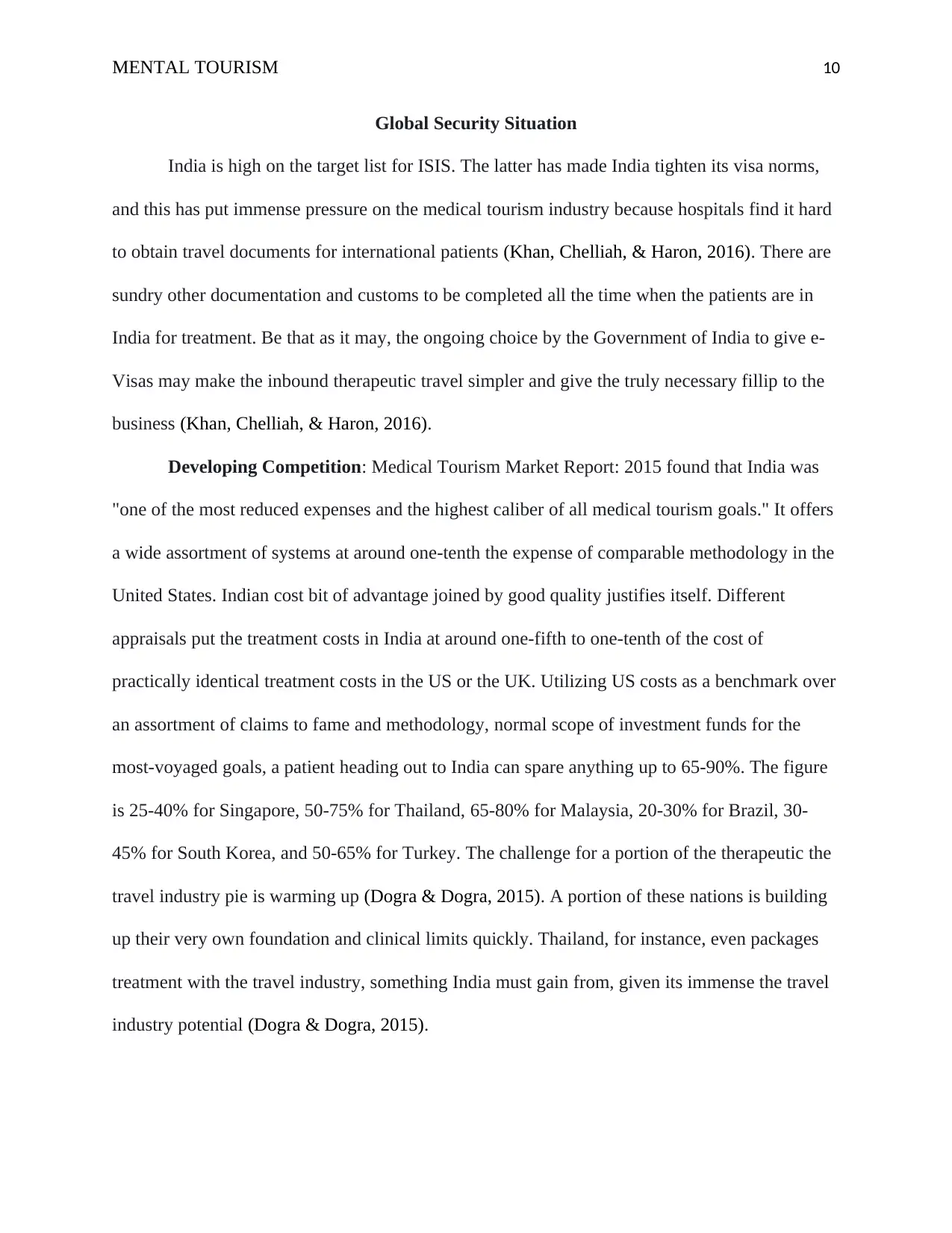
MENTAL TOURISM 10
Global Security Situation
India is high on the target list for ISIS. The latter has made India tighten its visa norms,
and this has put immense pressure on the medical tourism industry because hospitals find it hard
to obtain travel documents for international patients (Khan, Chelliah, & Haron, 2016). There are
sundry other documentation and customs to be completed all the time when the patients are in
India for treatment. Be that as it may, the ongoing choice by the Government of India to give e-
Visas may make the inbound therapeutic travel simpler and give the truly necessary fillip to the
business (Khan, Chelliah, & Haron, 2016).
Developing Competition: Medical Tourism Market Report: 2015 found that India was
"one of the most reduced expenses and the highest caliber of all medical tourism goals." It offers
a wide assortment of systems at around one-tenth the expense of comparable methodology in the
United States. Indian cost bit of advantage joined by good quality justifies itself. Different
appraisals put the treatment costs in India at around one-fifth to one-tenth of the cost of
practically identical treatment costs in the US or the UK. Utilizing US costs as a benchmark over
an assortment of claims to fame and methodology, normal scope of investment funds for the
most-voyaged goals, a patient heading out to India can spare anything up to 65-90%. The figure
is 25-40% for Singapore, 50-75% for Thailand, 65-80% for Malaysia, 20-30% for Brazil, 30-
45% for South Korea, and 50-65% for Turkey. The challenge for a portion of the therapeutic the
travel industry pie is warming up (Dogra & Dogra, 2015). A portion of these nations is building
up their very own foundation and clinical limits quickly. Thailand, for instance, even packages
treatment with the travel industry, something India must gain from, given its immense the travel
industry potential (Dogra & Dogra, 2015).
Global Security Situation
India is high on the target list for ISIS. The latter has made India tighten its visa norms,
and this has put immense pressure on the medical tourism industry because hospitals find it hard
to obtain travel documents for international patients (Khan, Chelliah, & Haron, 2016). There are
sundry other documentation and customs to be completed all the time when the patients are in
India for treatment. Be that as it may, the ongoing choice by the Government of India to give e-
Visas may make the inbound therapeutic travel simpler and give the truly necessary fillip to the
business (Khan, Chelliah, & Haron, 2016).
Developing Competition: Medical Tourism Market Report: 2015 found that India was
"one of the most reduced expenses and the highest caliber of all medical tourism goals." It offers
a wide assortment of systems at around one-tenth the expense of comparable methodology in the
United States. Indian cost bit of advantage joined by good quality justifies itself. Different
appraisals put the treatment costs in India at around one-fifth to one-tenth of the cost of
practically identical treatment costs in the US or the UK. Utilizing US costs as a benchmark over
an assortment of claims to fame and methodology, normal scope of investment funds for the
most-voyaged goals, a patient heading out to India can spare anything up to 65-90%. The figure
is 25-40% for Singapore, 50-75% for Thailand, 65-80% for Malaysia, 20-30% for Brazil, 30-
45% for South Korea, and 50-65% for Turkey. The challenge for a portion of the therapeutic the
travel industry pie is warming up (Dogra & Dogra, 2015). A portion of these nations is building
up their very own foundation and clinical limits quickly. Thailand, for instance, even packages
treatment with the travel industry, something India must gain from, given its immense the travel
industry potential (Dogra & Dogra, 2015).
Paraphrase This Document
Need a fresh take? Get an instant paraphrase of this document with our AI Paraphraser
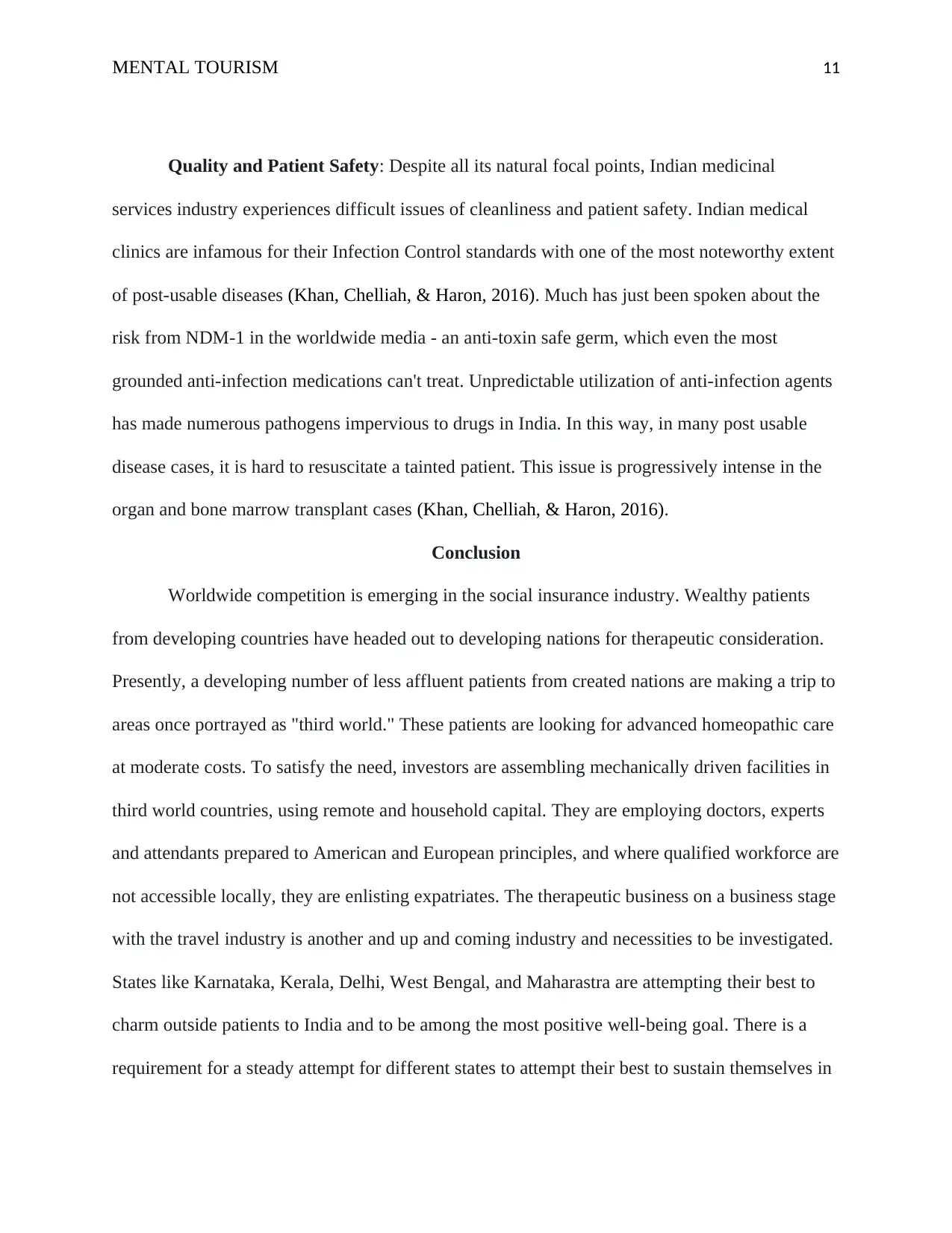
MENTAL TOURISM 11
Quality and Patient Safety: Despite all its natural focal points, Indian medicinal
services industry experiences difficult issues of cleanliness and patient safety. Indian medical
clinics are infamous for their Infection Control standards with one of the most noteworthy extent
of post-usable diseases (Khan, Chelliah, & Haron, 2016). Much has just been spoken about the
risk from NDM-1 in the worldwide media - an anti-toxin safe germ, which even the most
grounded anti-infection medications can't treat. Unpredictable utilization of anti-infection agents
has made numerous pathogens impervious to drugs in India. In this way, in many post usable
disease cases, it is hard to resuscitate a tainted patient. This issue is progressively intense in the
organ and bone marrow transplant cases (Khan, Chelliah, & Haron, 2016).
Conclusion
Worldwide competition is emerging in the social insurance industry. Wealthy patients
from developing countries have headed out to developing nations for therapeutic consideration.
Presently, a developing number of less affluent patients from created nations are making a trip to
areas once portrayed as "third world." These patients are looking for advanced homeopathic care
at moderate costs. To satisfy the need, investors are assembling mechanically driven facilities in
third world countries, using remote and household capital. They are employing doctors, experts
and attendants prepared to American and European principles, and where qualified workforce are
not accessible locally, they are enlisting expatriates. The therapeutic business on a business stage
with the travel industry is another and up and coming industry and necessities to be investigated.
States like Karnataka, Kerala, Delhi, West Bengal, and Maharastra are attempting their best to
charm outside patients to India and to be among the most positive well-being goal. There is a
requirement for a steady attempt for different states to attempt their best to sustain themselves in
Quality and Patient Safety: Despite all its natural focal points, Indian medicinal
services industry experiences difficult issues of cleanliness and patient safety. Indian medical
clinics are infamous for their Infection Control standards with one of the most noteworthy extent
of post-usable diseases (Khan, Chelliah, & Haron, 2016). Much has just been spoken about the
risk from NDM-1 in the worldwide media - an anti-toxin safe germ, which even the most
grounded anti-infection medications can't treat. Unpredictable utilization of anti-infection agents
has made numerous pathogens impervious to drugs in India. In this way, in many post usable
disease cases, it is hard to resuscitate a tainted patient. This issue is progressively intense in the
organ and bone marrow transplant cases (Khan, Chelliah, & Haron, 2016).
Conclusion
Worldwide competition is emerging in the social insurance industry. Wealthy patients
from developing countries have headed out to developing nations for therapeutic consideration.
Presently, a developing number of less affluent patients from created nations are making a trip to
areas once portrayed as "third world." These patients are looking for advanced homeopathic care
at moderate costs. To satisfy the need, investors are assembling mechanically driven facilities in
third world countries, using remote and household capital. They are employing doctors, experts
and attendants prepared to American and European principles, and where qualified workforce are
not accessible locally, they are enlisting expatriates. The therapeutic business on a business stage
with the travel industry is another and up and coming industry and necessities to be investigated.
States like Karnataka, Kerala, Delhi, West Bengal, and Maharastra are attempting their best to
charm outside patients to India and to be among the most positive well-being goal. There is a
requirement for a steady attempt for different states to attempt their best to sustain themselves in
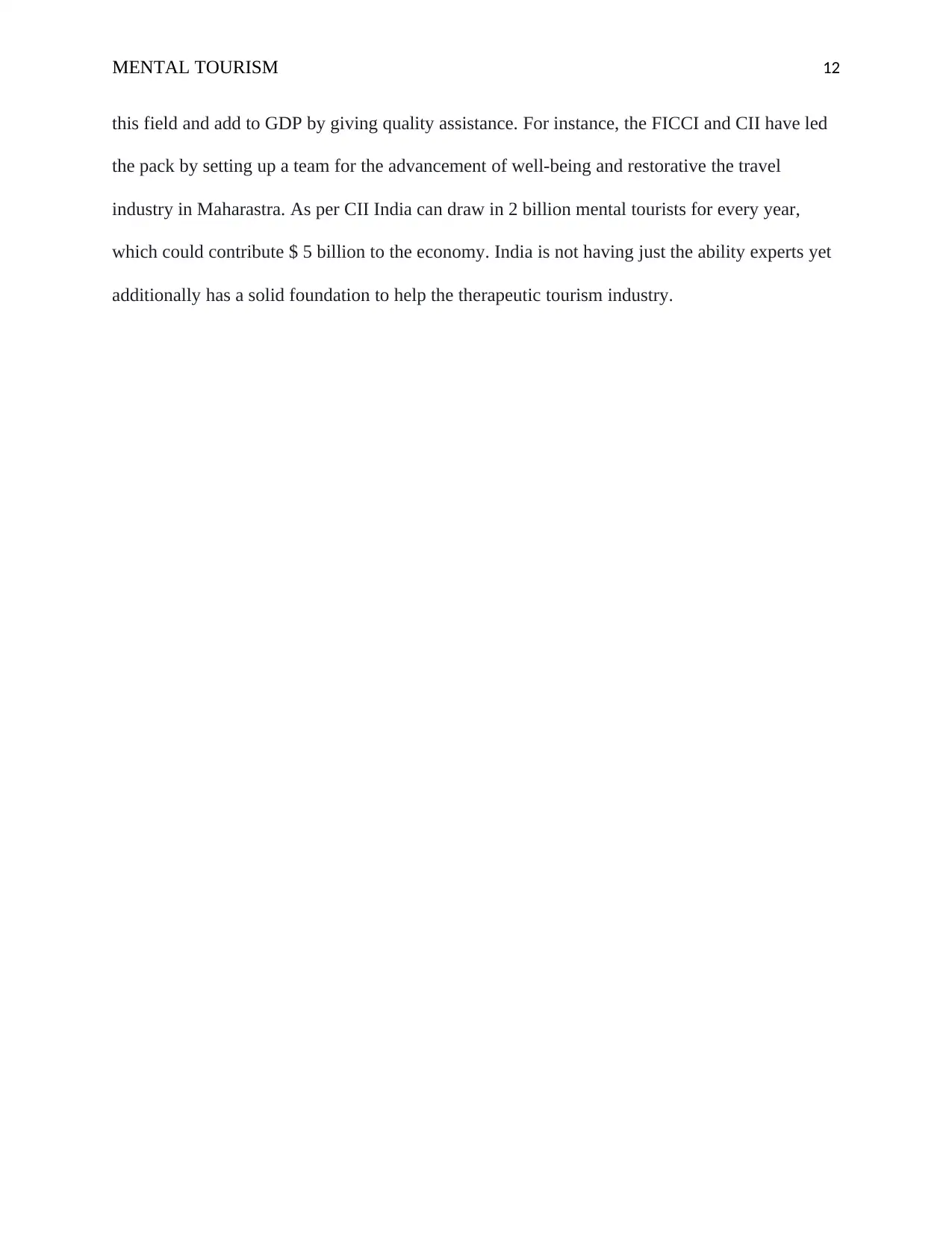
MENTAL TOURISM 12
this field and add to GDP by giving quality assistance. For instance, the FICCI and CII have led
the pack by setting up a team for the advancement of well-being and restorative the travel
industry in Maharastra. As per CII India can draw in 2 billion mental tourists for every year,
which could contribute $ 5 billion to the economy. India is not having just the ability experts yet
additionally has a solid foundation to help the therapeutic tourism industry.
this field and add to GDP by giving quality assistance. For instance, the FICCI and CII have led
the pack by setting up a team for the advancement of well-being and restorative the travel
industry in Maharastra. As per CII India can draw in 2 billion mental tourists for every year,
which could contribute $ 5 billion to the economy. India is not having just the ability experts yet
additionally has a solid foundation to help the therapeutic tourism industry.
⊘ This is a preview!⊘
Do you want full access?
Subscribe today to unlock all pages.

Trusted by 1+ million students worldwide
1 out of 14
Related Documents
Your All-in-One AI-Powered Toolkit for Academic Success.
+13062052269
info@desklib.com
Available 24*7 on WhatsApp / Email
![[object Object]](/_next/static/media/star-bottom.7253800d.svg)
Unlock your academic potential
Copyright © 2020–2025 A2Z Services. All Rights Reserved. Developed and managed by ZUCOL.





